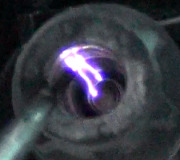It's called the "Crankshaft Position Sensor". There is also a Camshaft Position Sensor on the top front of the engine that can cause the same problem.
By throwing parts at it in an attempt to get it started, you might have opened up an expensive can of worms. If your car has the factory-installed anti-theft system, you have nothing to worry about, however, if it does not have that feature, you MUST install a used engine computer from a car that also did not have anti-theft. Most salvage yards don't have that information so you're really taking a chance on installing their part.
When you put in an engine computer OR a body computer with anti-theft programming, it will teach that programming to the other computer. That "upgrade" can not be undone. From now on, both computers will only work in a car with the factory anti-theft system. They will require the "Fuel Allowed" signal from the anti-theft system for the engine to start, but that signal is never coming because that feature isn't on the car.
If you installed a used engine computer with the anti-theft upgrade, it taught that programming to your body computer. If you put your old engine computer back in, the body computer will teach the programming to your old engine computer. Now you still have the original problem AND you must replace both of the computers.
Chrysler engine computers give very little trouble. By "no power to the spark plugs", I assume you mean there's no spark. That's only half the diagnosis. You also need to check for fuel. An easier way to diagnose this system is to connect a test light to either of the small wires plugged into the back of the alternator. The light should turn on for about two seconds when the ignition switch is turned on, then it will go off again until the computer detects engine rotation, (cranking or running). If it comes on for those two seconds, the Automatic Shutdown (ASD) relay is working. It supplies voltage to the alternator field, (where the test light is connected), the coil pack, the injectors, and the fuel pump or pump relay. The ASD relay turns on again when pulses are received from the crankshaft position sensor and the camshaft position sensor.
If the test light turns on during engine cranking, the camshaft and crankshaft position sensors are working.
Normally the engine computer will detect the defective sensor and memorize a diagnostic fault code and turn on the "Check Engine" light on the dash. That valuable information will be lost if the battery is disconnected or run dead. In rare instances, one of those sensors will short out the 8 volt power supply from the engine computer. To protect itself, the computer shuts that power supply down until the short is gone and the ignition switch is cycled off and back on. Since power is lost to both position sensors, both signals are lost and the computer assumes the engine has stopped and no fault code is put in memory. When only one signal is lost, the computer knows it because signals are still coming from the other sensor as the engine coasts to a stop.
You can check for the 8 volts on the camshaft position sensor on the top front of the engine, but use a digital voltmeter, not the test light. Test lights draw way too much current for a computer circuit to supply. At the least, you'll get inaccurate readings; at most, you can damage computers with a test light.
The cam sensor has three wires. With the ignition switch in the "run" position, one wire must measure near 0 volts, and one must have 8 volts. The voltage on the third wire will bounce around while cranking the engine and can't be measured accurately with a digital voltmeter. If it stays at 0 or 8 volts, it's likely defective.
Caradiodoc
Friday, May 29th, 2009 AT 4:03 AM



